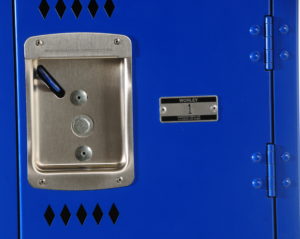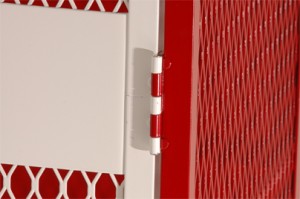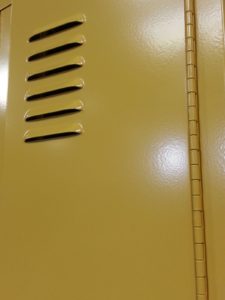You should know that your whole locker could hinge on the decision you make about your hinge.
Just kidding, there’s a lot that goes into making a great locker! But it’s also true that a locker’s hinge is an important part. Here are the three main types of hinges for lockers and how to choose which is best for which lockers.
2-Inch, 5 Knuckle Hinge
 Crafted from 18 gauge steel, this design originally came from cabinets, which are typically allowed to be more accessible. This hinge was used the most before a reliable heavy-duty hinge had been created. It attached at two points on the door and two points on the frame, sometimes with rivets welded to one side. Shorter lockers would use only one hinge while higher doors would feature three.
Crafted from 18 gauge steel, this design originally came from cabinets, which are typically allowed to be more accessible. This hinge was used the most before a reliable heavy-duty hinge had been created. It attached at two points on the door and two points on the frame, sometimes with rivets welded to one side. Shorter lockers would use only one hinge while higher doors would feature three.
As locker quality has progressed, these hinges have been chosen less and less frequently. They weren’t strong enough to sustain much use and couldn’t be leaned on without breaking. Students or hallways made for a bad combination, as speed and excitement often lead to rough use and numerous maintenance needs.
If budget is the main concern, you can still choose to use this hinge, but it would only work in places where there is no expectation of vandalism or abuse, need for extra security, or anticipated heavy use.
 Piano Hinge
Piano Hinge
Typically made of 16 gauge steel, this hinge covers the edge of the door from top to bottom. It is commonly used for hallway lockers in schools, providing a sleek, closed off look in addition to additional security. It is also ideal for heavily ventilated lockers; with this hinge, there is no way for a potential vandal to pry open the hinge.
The size of this hinge depends on the door and can have 5, 10, or 15 rivets per hinge. They are appropriate for many sizes and models of lockers. At only slightly pricier than the first hinge, these are not very expensive and are more than worth the cost. It is not practical to choose these for fully-framed lockers because of the way they are constructed, but it can be done if necessary.
3-Inch, 5 Knuckle Hinge
 Despite the name, these hinges can have anywhere from 5 to 7 knuckles, providing the strength of a much bigger loop and heavier material. This is a hinge that can be found on normal doors and looks just like a door hinge with a pin through it. It is welded on both sides to both the frame and the door, so its biggest advantage is that its rivets cannot be popped off, and it is extra ‘pry-proof.’
Despite the name, these hinges can have anywhere from 5 to 7 knuckles, providing the strength of a much bigger loop and heavier material. This is a hinge that can be found on normal doors and looks just like a door hinge with a pin through it. It is welded on both sides to both the frame and the door, so its biggest advantage is that its rivets cannot be popped off, and it is extra ‘pry-proof.’
Often used in PE rooms or on big doors, this hinge can be found on fully formed lockers and is most common on angle iron constructed box doors. The heavier the door, the stronger the hinge needs to be, and this hinge is made of the heaviest material.
Factors To Consider
When choosing the hinge, consider the security, appearance, durability, and strength that you will need. Remember that each part of the locker can reinforce one or more of these aspects, or undermine it. Pick a hinge that your locker and its user can rely on!
Are you all set to remodel over the winter break? Get all the details for your brand new, state-of-the-art lockers to feature in your updated space! Contact DeBourgh Lockers now.
